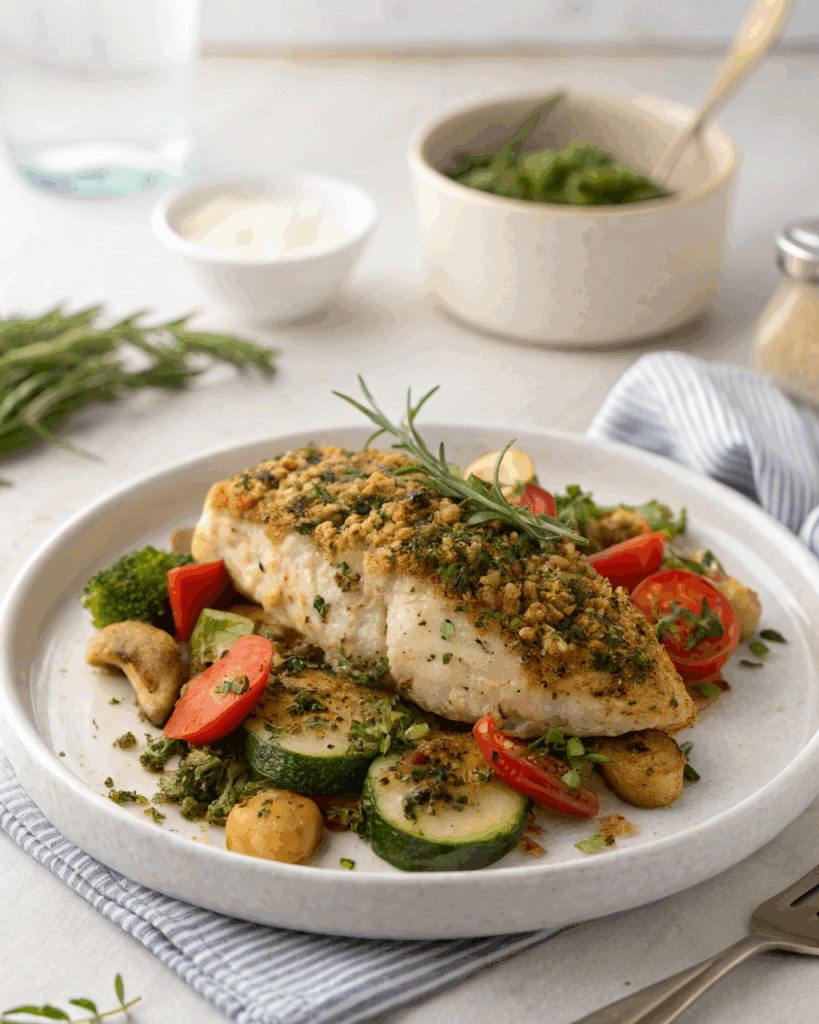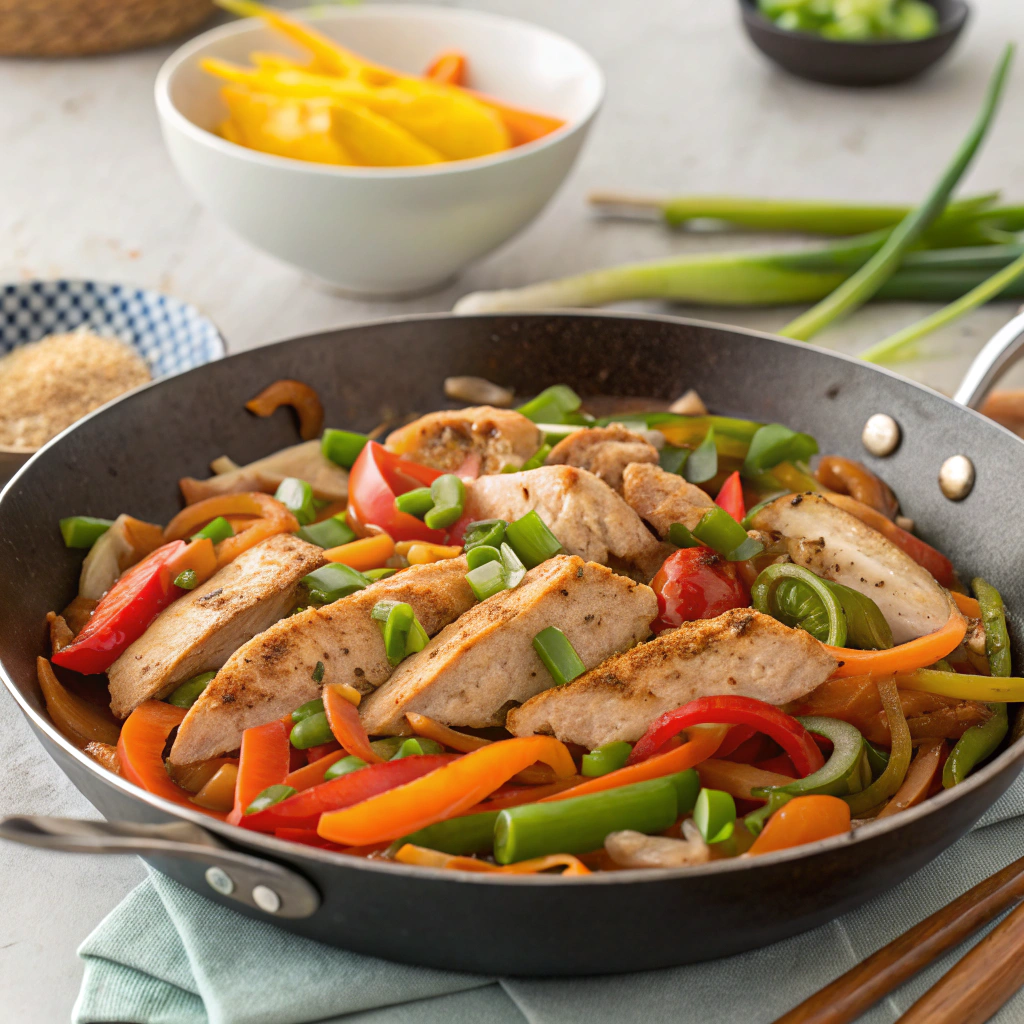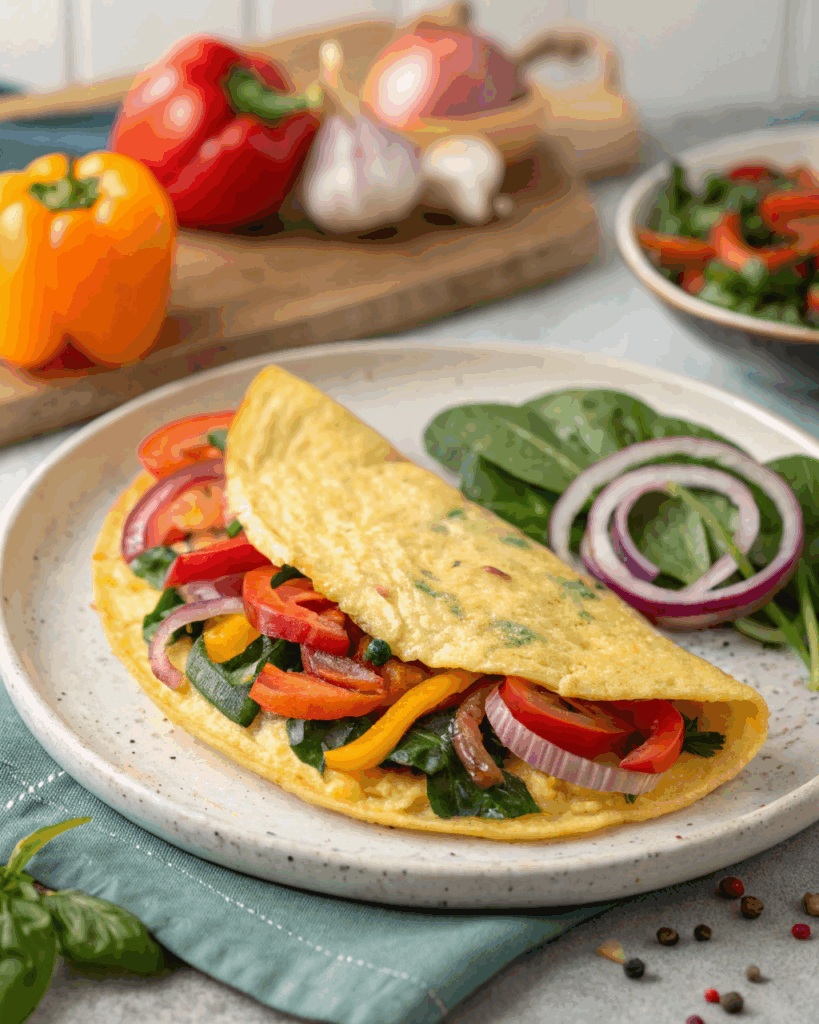In today’s fast-paced world, maintaining a heart-healthy diet while enjoying flavorful, satisfying meals can seem like an impossible balancing act. However, with the right approach to cooking and seasoning, you can create dishes that not only support cardiovascular health but also delight your taste buds. Enter the Low Sodium Herb-Crusted Chicken – a culinary masterpiece that proves heart-healthy eating doesn’t mean sacrificing flavor or satisfaction.
This remarkable dish represents the perfect fusion of nutritional science and culinary artistry. By dramatically reducing sodium content while maximizing the natural flavors of fresh herbs and spices, this recipe demonstrates that healthy eating can be both delicious and deeply satisfying. The herb crust creates a golden, aromatic exterior that locks in the chicken’s natural juices, resulting in a meal that’s as visually appealing as it is nutritionally beneficial.
Heart disease remains one of the leading health concerns worldwide, with dietary factors playing a crucial role in both prevention and management. The American Heart Association recommends limiting sodium intake to no more than 2,300 milligrams per day, with an ideal limit of 1,500 milligrams for most adults. Traditional chicken preparations often rely heavily on salt and sodium-rich seasonings, making it challenging to create flavorful dishes within these guidelines. This herb-crusted chicken recipe addresses this challenge head-on, proving that with creativity and the right combination of ingredients, you can create meals that support heart health without compromising on taste.
The beauty of this recipe lies not just in its health benefits, but in its accessibility and versatility. Using readily available ingredients and simple cooking techniques, this dish can easily become a regular part of your weekly meal rotation. The herb crust is customizable, allowing you to experiment with different combinations of fresh and dried herbs based on your preferences and what’s available in your garden or local market.
Beyond its immediate appeal, this dish serves as an excellent introduction to the principles of heart-healthy cooking. It demonstrates how natural flavors can be enhanced and amplified through proper seasoning techniques, cooking methods, and ingredient combinations. The recipe serves as a foundation that can be adapted and modified to create numerous variations, each maintaining the core principles of low sodium, high flavor, and heart-healthy nutrition.
The herbs used in this recipe aren’t just flavor enhancers – they’re nutritional powerhouses in their own right. Fresh herbs like rosemary, thyme, and oregano contain antioxidants, anti-inflammatory compounds, and essential oils that contribute to overall health and well-being. When combined with lean protein from chicken breast, this dish provides a complete, balanced meal that supports not just heart health, but overall nutritional wellness.
This recipe also addresses the common misconception that healthy food is bland or boring. The herb crust creates complex layers of flavor that develop and intensify during cooking, resulting in a dish that’s aromatic, savory, and deeply satisfying. The combination of different herbs creates a symphony of flavors that changes and evolves with each bite, making every meal an engaging culinary experience.
For families looking to improve their overall eating habits, this dish serves as an excellent starting point. It’s mild enough for children while sophisticated enough for adult palates, making it an ideal choice for family dinners. The recipe can easily be scaled up for larger gatherings or meal prep, making it a practical choice for busy households.
The cooking method used in this recipe – baking at a moderate temperature – ensures that the chicken remains moist and tender while developing a beautifully golden, crispy exterior. This technique also makes the dish relatively hands-off once it’s in the oven, freeing you to prepare accompanying sides or spend time with family.
Low Sodium Herb-Crusted Chicken – Heart Healthy Dinner Ingredients
Creating the perfect Low Sodium Herb-Crusted Chicken requires careful selection of high-quality ingredients that work together to maximize flavor while minimizing sodium content. Each component of this recipe has been chosen not only for its taste contribution but also for its nutritional benefits and heart-healthy properties.
Main Protein Component:
- 4 boneless, skinless chicken breasts (approximately 6-8 ounces each)
- Choose organic, free-range chicken when possible for optimal flavor and nutritional value
The foundation of this dish is high-quality chicken breast, which provides lean protein essential for heart health. Chicken breast is naturally low in sodium and high in protein, making it an ideal choice for those following heart-healthy dietary guidelines. When selecting chicken breasts, look for pieces that are similar in size and thickness to ensure even cooking. If your chicken breasts are particularly thick (more than 1 inch), consider butterflying them or pounding them to an even thickness for optimal cooking results.
Fresh Herb Blend:
- 2 tablespoons fresh rosemary, finely chopped
- 2 tablespoons fresh thyme leaves
- 2 tablespoons fresh oregano, chopped
- 1 tablespoon fresh sage, minced
- 2 tablespoons fresh parsley, finely chopped
Fresh herbs form the heart of this recipe’s flavor profile. Rosemary provides a pine-like, aromatic quality that pairs beautifully with chicken. Its antioxidant properties and distinctive flavor make it a cornerstone of Mediterranean cooking. Thyme contributes earthy, slightly minty notes and contains compounds that may help support immune function. Oregano brings a warm, pungent flavor that’s both familiar and comforting, while sage adds a subtle earthiness and depth. Fresh parsley not only provides color but also contributes a bright, clean flavor that balances the more robust herbs.
Dried Herb and Spice Enhancement:
- 1 teaspoon dried basil
- 1 teaspoon dried marjoram
- 1/2 teaspoon dried tarragon
- 1 teaspoon garlic powder
- 1 teaspoon onion powder
- 1/2 teaspoon sweet paprika
- 1/4 teaspoon black pepper, freshly ground
- 1/8 teaspoon cayenne pepper (optional, for heat)
The combination of dried herbs and spices adds complexity and depth to the fresh herb blend. Dried basil provides a concentrated, slightly sweet flavor that complements the fresh herbs beautifully. Marjoram offers a delicate, sweet taste similar to oregano but milder. Tarragon contributes a distinctive anise-like flavor that adds sophistication to the blend. Garlic and onion powders provide savory depth without the need for added sodium, while paprika contributes both color and a mild, sweet pepper flavor. Freshly ground black pepper adds a sharp, pungent note that enhances all the other flavors.
Binding and Texture Components:
- 1/2 cup whole wheat panko breadcrumbs
- 2 tablespoons almond flour
- 2 tablespoons grated Parmesan cheese (optional, for additional flavor)
- 2 tablespoons extra virgin olive oil
- 1 large egg white, lightly beaten
- 1 tablespoon Dijon mustard (no-salt-added variety)
- 1 tablespoon fresh lemon juice
Whole wheat panko breadcrumbs provide the textural foundation for the herb crust, creating a light, crispy coating that doesn’t overpower the chicken. The addition of almond flour adds richness and helps the crust adhere better to the chicken while contributing healthy fats and protein. A small amount of Parmesan cheese can be included for additional flavor complexity, though it should be used sparingly due to its sodium content.
Extra virgin olive oil serves multiple purposes in this recipe. It helps bind the herb mixture, promotes browning and crisping of the crust, and provides heart-healthy monounsaturated fats. The egg white acts as a natural binding agent, helping the herb crust adhere to the chicken during cooking. Dijon mustard (choose a no-salt-added variety) adds tanginess and helps the crust stick to the chicken while contributing minimal sodium. Fresh lemon juice brightens all the flavors and helps tenderize the chicken slightly.
Flavor Enhancement Ingredients:
- Zest of 1 large lemon
- 2 cloves fresh garlic, minced
- 1 small shallot, finely minced
- 1 tablespoon white wine vinegar (optional)
- 1/2 teaspoon honey (optional, for balance)
Lemon zest provides intense citrus flavor without any sodium, while fresh garlic and shallots add aromatic depth. White wine vinegar can be used to add acidity and brightness, while a touch of honey helps balance the herbs’ intensity and promotes browning of the crust.
Quality Considerations:
When selecting ingredients, prioritize freshness and quality. Fresh herbs should be vibrant in color and free from dark spots or wilting. If fresh herbs aren’t available, you can substitute with dried herbs using a 1:3 ratio (1 teaspoon dried for every 3 teaspoons fresh), though the flavor will be less bright and complex.
Choose extra virgin olive oil for its superior flavor and health benefits. The oil should smell fresh and fruity, not rancid or overly peppery. Store herbs properly to maintain their freshness – most can be stored in the refrigerator wrapped in slightly damp paper towels and placed in plastic bags.
For the chicken, ensure it’s stored at proper temperatures and used within the recommended timeframes. The chicken should smell fresh and have a firm texture. If using frozen chicken, thaw it completely in the refrigerator before preparing the recipe.
How to Make Low Sodium Herb-Crusted Chicken – Heart Healthy Dinner
Creating the perfect Low Sodium Herb-Crusted Chicken requires attention to detail and proper technique to ensure the chicken is cooked through while maintaining its moisture and developing a beautifully golden, flavorful crust. This step-by-step guide will walk you through each stage of the process, from preparation to final plating.
Step 1: Preparation and Setup
Begin by preheating your oven to 400°F (200°C). This temperature is ideal for cooking chicken breast thoroughly while allowing the herb crust to develop a golden color without burning. Position an oven rack in the center position to ensure even heating around the chicken.
Line a large rimmed baking sheet with parchment paper or lightly oil it with a small amount of olive oil. This prevents sticking and makes cleanup easier. If you have a wire cooling rack that fits inside your baking sheet, place it on top of the lined pan. This allows air to circulate around the chicken, promoting more even cooking and helping achieve a crispier crust on all sides.
Step 2: Chicken Preparation
Remove the chicken breasts from the refrigerator 15-20 minutes before cooking to allow them to come closer to room temperature. This ensures more even cooking throughout the meat. Pat the chicken breasts completely dry with paper towels – this step is crucial for achieving good crust adherence and proper browning.
Examine each chicken breast and trim away any excess fat or connective tissue. If the chicken breasts are uneven in thickness, place them between two pieces of plastic wrap or parchment paper and gently pound them to an even thickness of about 3/4 inch. This ensures uniform cooking and prevents some pieces from drying out while others remain undercooked.
Using a sharp knife, score the surface of each chicken breast lightly in a crosshatch pattern, making shallow cuts about 1/8 inch deep. This technique helps the flavors penetrate the meat and provides more surface area for the crust to adhere to.
Step 3: Creating the Herb Crust Mixture
In a large mixing bowl, combine all the fresh herbs: rosemary, thyme, oregano, sage, and parsley. Using your fingers or a fork, gently toss them together to distribute evenly. Add the dried herbs and spices: basil, marjoram, tarragon, garlic powder, onion powder, paprika, black pepper, and cayenne (if using).
Add the whole wheat panko breadcrumbs and almond flour to the herb mixture. If using Parmesan cheese, add it now. Gently toss all the dry ingredients together until well combined. The mixture should be fragrant and evenly colored.
Create a well in the center of the dry mixture and add the minced fresh garlic, shallot, and lemon zest. Drizzle the olive oil over the mixture, then add the lemon juice and white wine vinegar (if using). Using a fork or your fingers, work the wet ingredients into the dry ingredients until the mixture resembles coarse, moist crumbs that hold together when pressed lightly.
Step 4: Preparing the Binding Mixture
In a shallow dish or pie pan, whisk together the egg white and Dijon mustard until well combined. If using honey, add it to this mixture and whisk until fully incorporated. This mixture will help the herb crust adhere to the chicken and create a golden color during baking.
Step 5: Coating the Chicken
Working with one piece of chicken at a time, brush or rub each breast with the egg white and mustard mixture, ensuring all surfaces are covered. This step is crucial for proper crust adherence.
Place the coated chicken breast in the bowl with the herb crust mixture. Using your hands, press the herb mixture firmly onto all surfaces of the chicken, ensuring even coverage. The coating should be thick enough to completely cover the chicken but not so thick that it falls off during cooking.
As you finish coating each piece, place it on the prepared baking sheet or wire rack. Leave some space between pieces to allow for proper air circulation.
Step 6: Final Preparation Before Baking
Once all chicken breasts are coated, lightly drizzle or brush the tops with a small amount of additional olive oil. This helps promote browning and crisping of the crust. At this point, you can cover the chicken and refrigerate for up to 2 hours if you want to prepare it ahead of time. This resting period can actually help the flavors meld and the coating to adhere better.
Step 7: Baking Process
Place the baking sheet in the preheated oven and bake for 20-25 minutes, depending on the thickness of your chicken breasts. The internal temperature should reach 165°F (74°C) when measured with an instant-read thermometer inserted into the thickest part of the breast.
Avoid opening the oven door unnecessarily during the first 15 minutes of cooking, as this can cause temperature fluctuations that may affect the crust development. After 15 minutes, you can check the progress and rotate the pan if needed for even browning.
Step 8: Testing for Doneness
The chicken is done when the internal temperature reaches 165°F (74°C) and the juices run clear when the thickest part is pierced with a knife. The crust should be golden brown and crispy. If the crust is browning too quickly but the chicken isn’t fully cooked, you can tent it loosely with foil and continue cooking.
Step 9: Resting and Serving
Once cooked, remove the chicken from the oven and let it rest for 5-10 minutes before serving. This resting period allows the juices to redistribute throughout the meat, ensuring maximum moisture and tenderness.
Step 10: Final Presentation
Transfer the rested chicken to serving plates and garnish with fresh herbs, lemon wedges, or a light sprinkle of additional fresh herbs if desired. The chicken can be served whole or sliced diagonally to showcase the herb crust and moist interior.
Pro Tips for Success:
- Use an instant-read thermometer to ensure accuracy in cooking temperature
- If your herb crust is browning too quickly, reduce the oven temperature to 375°F and cook for a few minutes longer
- Don’t overcrowd the baking sheet – this can cause steaming rather than proper browning
- Save any leftover herb mixture for future use – it can be stored in the refrigerator for up to a week
- For extra crispiness, you can place the chicken under the broiler for 1-2 minutes at the end of cooking, watching carefully to prevent burning
Troubleshooting Common Issues:
If the crust isn’t sticking well, make sure your chicken is completely dry before coating and that you’re pressing the mixture firmly onto the surface. If the chicken is cooking unevenly, check that all pieces are similar in thickness and that your oven temperature is accurate.
For those who prefer a spicier version, increase the cayenne pepper or add red pepper flakes to the herb mixture. Conversely, if serving to those with sensitive palates, omit the cayenne entirely and reduce the black pepper.
This method creates a beautifully seasoned, heart-healthy meal that proves low-sodium cooking doesn’t mean sacrificing flavor or satisfaction. The combination of proper technique and quality ingredients results in a dish that’s both nutritious and delicious.
What to Serve with Low Sodium Herb-Crusted Chicken – Heart Healthy Dinner
Creating a complete heart-healthy meal around your Low Sodium Herb-Crusted Chicken involves selecting complementary side dishes and accompaniments that not only enhance the flavors of the main course but also contribute to the overall nutritional balance of the meal. The key is choosing sides that are rich in fiber, vitamins, and minerals while maintaining the low-sodium profile that makes this dinner so heart-friendly.
Heart-Healthy Vegetable Sides
Roasted vegetables make an excellent accompaniment to herb-crusted chicken, and the cooking method allows you to prepare them alongside the chicken for convenience. Consider a medley of colorful vegetables such as Brussels sprouts halved and tossed with a small amount of olive oil, balsamic vinegar, and fresh thyme. The slight caramelization that occurs during roasting brings out natural sweetness that pairs beautifully with the savory herb crust.
Rainbow carrots, when roasted with rosemary and a touch of honey, create a sweet and earthy contrast to the chicken’s savory profile. Their natural sweetness helps balance the herbs while providing beta-carotene and fiber. Cut them into uniform pieces to ensure even cooking, and consider leaving some of the green tops on for visual appeal.
Asparagus spears, lightly tossed with olive oil and finished with lemon zest, provide a crisp texture contrast and fresh flavor that complements the herb crust beautifully. Their natural affinity for lemon makes them a perfect pairing, and they cook quickly, making them ideal for busy weeknight dinners.
For a Mediterranean-inspired side, consider ratatouille – a stewed vegetable dish that combines eggplant, zucchini, bell peppers, tomatoes, and onions with herbs like basil and oregano. This dish can be made ahead of time and reheated, making it perfect for meal planning. The vegetables provide fiber, antioxidants, and complex flavors that complement without competing with the chicken.
Grain and Starch Accompaniments
Quinoa pilaf makes an excellent heart-healthy grain side that can be enhanced with herbs and vegetables. Cook quinoa in low-sodium vegetable broth, then stir in diced cucumber, cherry tomatoes, fresh herbs like parsley and mint, and a simple lemon vinaigrette. This provides complete protein, fiber, and a fresh, light texture that doesn’t compete with the chicken.
Wild rice stuffing, made with celery, onions, mushrooms, and fresh herbs, offers a nutty flavor and chewy texture that pairs wonderfully with the tender chicken. The earthy flavors complement the herb crust while providing complex carbohydrates and fiber.
For a lighter option, cauliflower rice seasoned with herbs and a small amount of low-sodium broth creates a low-carb alternative that still feels substantial. You can enhance it with diced bell peppers, onions, and fresh herbs for additional flavor and nutrition.
Sweet potato wedges, roasted with rosemary and a touch of olive oil, provide natural sweetness, beta-carotene, and fiber. Their creamy texture and sweet flavor create a nice contrast to the savory, crispy chicken crust.
Fresh and Raw Accompaniments
A crisp, colorful salad provides freshness and helps balance the richness of the herb-crusted chicken. Consider a mixed green salad with arugula, spinach, and butter lettuce, topped with sliced cucumber, cherry tomatoes, and thinly sliced red onion. Dress it with a simple vinaigrette made from olive oil, lemon juice, Dijon mustard, and fresh herbs.
A Mediterranean chickpea salad combines protein-rich legumes with fresh vegetables like diced cucumber, cherry tomatoes, red onion, and fresh herbs. The creamy texture of the chickpeas provides substance while the fresh vegetables add crunch and brightness.
For a unique twist, try a fennel and orange salad with fresh herbs. The crisp, anise-like flavor of fennel pairs surprisingly well with the herb-crusted chicken, while orange segments add sweetness and vitamin C. Dress lightly with olive oil and fresh lemon juice.
Sauce and Condiment Options
While the herb-crusted chicken is flavorful on its own, certain low-sodium sauces can enhance the dining experience. A fresh chimichurri made with parsley, cilantro, garlic, olive oil, and vinegar provides bright, fresh flavors that complement the herbs in the crust.
A light lemon-herb yogurt sauce, made with Greek yogurt, fresh lemon juice, minced garlic, and chopped fresh herbs, offers coolness and tang that balances the savory chicken. Greek yogurt provides probiotics and protein while keeping the sauce light and healthy.
Homemade pesto, made with fresh basil, pine nuts, garlic, olive oil, and a small amount of Parmesan cheese, creates a rich, flavorful accompaniment. Use it sparingly as a dollop on the side or drizzled lightly over the chicken.
Soup Course Options
Starting the meal with a light, low-sodium soup can help create satiety while adding vegetables to the meal. A simple vegetable broth with fresh herbs and diced vegetables provides warmth and comfort without heaviness. Consider a light tomato and fresh basil soup, or a clear broth with julienned vegetables and herbs.
A butternut squash soup, naturally sweet and creamy without added cream, provides beta-carotene and fiber. Season with fresh sage and a touch of nutmeg for warmth and complexity.
Bread and Grain-Based Sides
Whole grain dinner rolls or crusty artisan bread can round out the meal, though they should be chosen carefully to maintain the low-sodium profile. Look for breads made without added salt or make your own herb focaccia using the same herbs featured in the chicken crust.
A wild rice and herb stuffing, baked separately or alongside the chicken, incorporates similar flavors while providing complex carbohydrates and fiber. Use low-sodium broth and plenty of fresh herbs to keep flavors bright and complementary.
Beverage Pairings
The beverages you choose can enhance the overall dining experience. Water infused with cucumber, lemon, or fresh herbs provides hydration while complementing the meal’s flavors. Herbal teas, either hot or iced, can provide antioxidants and interesting flavor combinations.
For those who enjoy wine, a light white wine such as Sauvignon Blanc or Pinot Grigio pairs well with the herbs and doesn’t overpower the chicken. The acidity in these wines helps cleanse the palate between bites.
Dessert Considerations
Light, fruit-based desserts work well after this hearty but healthy main course. Fresh berries with a dollop of Greek yogurt provide antioxidants and probiotics. A simple fruit salad with fresh mint adds freshness and helps cleanse the palate.
Poached pears with cinnamon provide natural sweetness and fiber while being light enough not to overwhelm after the substantial main course.
Meal Planning and Preparation Tips
Many of these sides can be prepared in advance or cooked alongside the chicken to streamline dinner preparation. Roasted vegetables can go in the oven at the same time as the chicken, while grain salads and slaws can be made hours ahead and actually improve in flavor as they sit.
Consider the colors, textures, and temperatures when planning your complete meal. A combination of warm and cool elements, soft and crispy textures, and varied colors creates a more satisfying and visually appealing dining experience.
The key to creating the perfect heart-healthy dinner lies in balancing flavors, textures, and nutritional components while maintaining the low-sodium profile that makes this meal so beneficial for cardiovascular health. By choosing complementary sides that enhance rather than compete with the herb-crusted chicken, you create a complete, satisfying meal that proves healthy eating can be both delicious and deeply satisfying.



